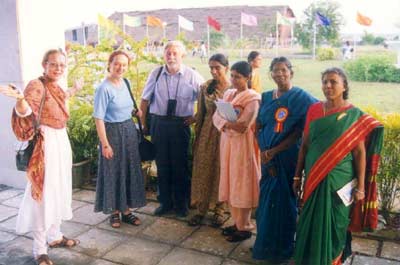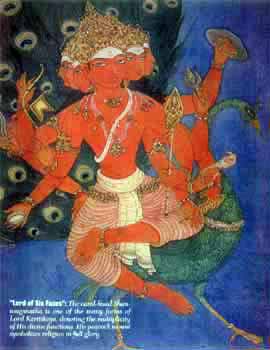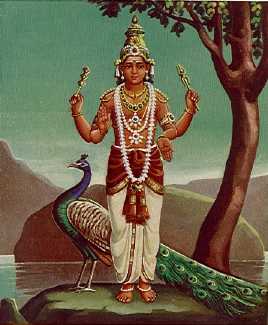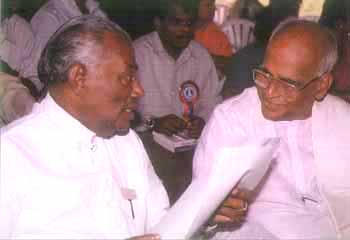
|
||||||||
|
| ||||||||
|
 |
|
Delegates at the First Murukan Conference
|

|
|
Conference delegates included the Vice-President of Mauritius and Sri Lankan Minister Thondaiman (centre) among others.
|

|
|
The Conference was an occasion for socializing also.
|

|
|
Delegates participated in a post-Conference tour of Aru Padai Veedu Temples, including Palani.
|
Academics didn't dominate. Swami Sankarananda of Chennai lauded Murugan's limitless compassion and Sadhu Ram gave insights into Saint Arunagirinathar's devotional songs. Acharya S. Nilamegame, a Mauritius yoga teacher, described Murugan worship in Reunion Island. In the technological arena, Chennai resident Jayalakshmi Sakthivelan reported that her interest in Hinduism "has motivated me to develop a multimedia CD-ROM on Murugan" and His temples. It's the first in an ambitious plan to produce 150 CDs on Hinduism.
T. Senthilwerl gave a deep perspective in his presentation on "Pilgrimage and Mystical Practice," reminding all that "Devotees who are pilgrimaging to fulfill vows are often underestimating Murugan by asking Him for small worldly favors. They should go with the thought in mind that it's possible to meet the Lord in person here in this world, especially at sacred places and sacred times. Also, in principle, one could encounter Him anywhere and anytime." Harrigan noted that this exalted point of view is difficult for those modern scholars--and even devotees--who have been influenced by Western education and values.
Vimala told Hinduism Today the interacting of savants and devotees was fruitful. "Scholars presented research, while devotees revealed higher truths and mystical secrets. The confluence of head and heart was indeed remarkable." Lady author Bala Rajes, from London, reported it to be "spiritually uplifting." Ending the conference was the creation of an International Association for the Study of Murugan-Skanda and a decision that Sri Lanka would host the next meeting in 2001.
Vimala was queried as to whether Murugan was generally regarded by delegates as a real God, or just an evolution of a historical person. She reported that out of 45 research papers she heard (a total of 135 were presented), 70 percent extolled Murugan as a divine God. "To Saivites," she shared, "He is no different from Siva. I also believe God is immanent and manifests in whatever form one adores Him." She said 25 percent did not touch on divinity, and five percent regarded Murugan as a historical figure--a human who with time became deified.
Institute director John Samuel opined the view that most scholars, including himself, believe Murugan was elevated from a historical person. The American-born Harrigan--whose "unabashed" devotion to Murugan raised eyebrows among "traditional" scholars at Berkeley University in California--feels differently. "For me, Murugan is not only my ishta devata (preferred deity) but also my supervisor and boss, my Supreme Commander if you will. He is very real and efficacious. This has sustained me for years and now it's beginning to bear fruit in the form of this conference, for instance." Harrigan is an expert on Murugan's famed shrine at Kataragama, Sri Lanka.
To balance the scholasticism, 70 delegates happily made a four-day pilgrimage for darshan of Murugan's Aru Padai Veedu, His six principal abodes in Tamil Nadu (a major trek). A scholar who joined the temple tour voiced more spiritual doubt--which Samuel and many academicians seem to have--saying he wasn't interested in psychologically-induced states of mind passing off as mystical experiences emanating from an unknowable source. But many foreign delegates, seeing the ancient temples for the first time, said it was their most memorable part of the conference. Bala Rajes reported that "Darshan at Tiruchendur created an atmosphere only people with devotion to Murugan can understand. Thousands of women, men, children, abled and disabled were all there to worship mighty Murugan. The rhythmic crush of waves from the sea, and cries of "aro hara" by devotees, mingled in harmony as God united man and nature in front of Him."
Harrigan says this intention underlaid the whole event: if there is a major conference bringing together Murugan scholars and devotees, then in principle He must also be present. "So, we took trouble to provide tasty meals and attractive entertainment. Because if we don't see the Lord among the crowd, we are convinced that He is still present. The conference is one small part of the His master campaign--whatever it may be. Not only I, but many devotees, viewed it on this level. The recent surge of interest in Murugan will tend to reinforce this view among bhaktas at least, if not among the media at large."


